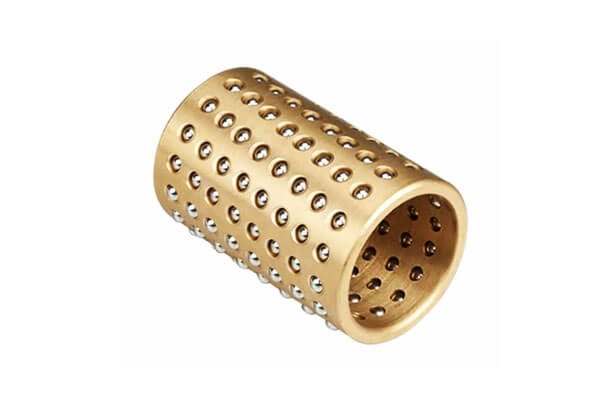1. 導入
精密機械部品の分野では, the 真鍮製ベアリングリテーナー 重要な役割を果たしていますが、過小評価されがちです.
転がり軸受内の構造フレームワークとして機能する, 転動体の均一な間隔を保証します (ボールまたはローラー), アライメントを維持します, 摩擦熱の発生を軽減します.
その貢献は、ベアリングアセンブリの動作安定性と寿命にとって極めて重要です。.
歴史的に, ベアリングリテーナは、初歩的な鋼または青銅の保持器から、性能を強化した合金で作られた精密設計コンポーネントに進化しました。.
これらの中で, 真鍮が好ましい素材として浮上, 並外れた強度の組み合わせのおかげで, 加工性, 耐食性, 焼付き防止特性.
このような特徴を持つ真鍮製リテーナーは高精度加工には欠かせないものとなっています。, ハイロード, 高速環境にも対応.
などの産業 自動車, 航空宇宙, 鉄道, 風力タービン, 産業機械, および海洋アプリケーション すべては真鍮製リテーナーの一貫した性能に依存しています。.
この記事で, 私たちは材料科学という多分野のレンズを通じて真鍮製ベアリングリテーナーを研究します。, エンジニアリングデザイン, 製造プロセス, 品質テスト, 産業用アプリケーション, とイノベーションのトレンド - 包括的な技術ガイドを提供.
2. 背景と定義
真鍮製ベアリングリテーナーとは?
a 真鍮製ベアリングリテーナーケージまたはセパレーターとも呼ばれる、ベアリング内のコンポーネントであり、均一な間隔と動作制御を維持しながら転動体を物理的に分離します。.
これにより、金属同士の接触が防止されます, それにより摩擦を最小限に抑えます, ノイズ, 回転時の発熱と.

主要なコンポーネントと機能
リテーナーは通常、次のもので構成されます。 精密に機械加工されたポケットまたは窓 個々のボールまたはローラーを収容する. これらのデザイン上の特徴:
- 要素の傾きや重なりを防ぐ.
- 均等な負荷分散をサポート.
- 回転コンポーネント間の最適な潤滑フローを促進します。.
3. 材料の特性と組成
真鍮の組成と合金
真鍮は、 銅の合金 (cu) と亜鉛 (Zn), 鉛などの微量元素で強化されることが多い (PB), 錫 (sn), またはアルミニウム (アル) パフォーマンス向上のために.
ベアリングリテーナーとして最も一般的に使用されるグレードは次のとおりです。:
| 真鍮グレード | 典型的な構成 | 特性 |
|---|---|---|
| カートリッジ真鍮 (C26000) | 70% cu, 30% Zn | 優れた延性と強度 |
| 自由に切断された真鍮 (C36000) | 61.5% cu, 35.5% Zn, 3% PB | 優れた加工性と精度 |
| 高強度黄銅 (C48500) | 58-60% 銅, 残りの亜鉛 & sn | 優れた耐摩耗性と疲労強度 |
標準と仕様
真鍮製ベアリングリテーナーは、次のような国際的な材料および寸法規格に準拠する必要があります。:
- ASTM B124/B16 黄銅棒および鍛造素材用.
- ISO 683-17 機械部品の銅合金用.
- Rohs そして 到着 環境コンプライアンスに関する指令.
4. デザインと機能性
真鍮製ベアリングリテーナの設計は、単に形状とサイズの問題ではなく、性能工学の重要な要素です。.
リテーナーのあらゆる幾何学的側面は、ベアリングの荷重分散に直接影響します。, 熱散逸, 振動減衰, と動作寿命.
真鍮, 機械的強度のバランスの取れた組み合わせにより、, 加工性, および熱安定性, エンジニアは、他の材料が制限する可能性のある方法で設計を最適化できます。.
構造設計の考慮事項
真鍮製ベアリングリテーナーの主な設計要素は次のとおりです。:
- ポケットの形状 (ボールまたはローラーの封じ込め用)
- リブとブリッジの厚さ
- ケージリングの寸法
- すきま公差
- 潤滑チャネルの統合
各機能はベアリングの機能に合わせて調整されています, アキシアル荷重下で動作するかどうか, ラジアル荷重, または両方の組み合わせ.
例えば, 電動モーターに使用される深溝玉軸受, a クラウン型真鍮リテーナー 高速回転中のボールの滑りを防ぐためによく使用されます。これは最大に達する可能性があります。 20,000 RPM 一部の産業用途では.
精度の面では, ポケットの同心度と肉厚の公差は、次のように厳しくすることができます。 ±0.01 mm, 動的操作中にボールが等距離に保たれるようにする.
真鍮は加工が容易なため、重大な工具の摩耗や変形のリスクを伴うことなく、このような高精度の要件の達成が容易になります。.

軸受組立における役割
単純な間隔を超えて, 真鍮のベアリングリテーナーは、ベアリングの効率に直接影響を与えるいくつかの複雑な機能を実行します。:
- ロード分布:
転動体の等間隔を維持することにより, リテーナーは、加えられた荷重がベアリング軌道を介して均一に伝達されることを保証します。, 早期疲労の原因となる点ストレスを軽減. - 摩擦の低減:
真鍮の低い摩擦係数 (通常、潤滑下の鋼に対して ~0.35) 内部抵抗の最小化に貢献, 高速または低トルク条件で重要. - 振動減衰:
真鍮の減衰能力は、スチールやポリマーの減衰能力よりも大幅に高くなります。, フレッチングやピッチングの原因となるノイズや微振動を軽減します。. - 給油の流れ:
リテーナーの設計には、潤滑剤の循環を促進するためにオイル チャネルまたはスロットが組み込まれている場合があります。.
このデザインの特徴は、, 真鍮の熱伝導率と組み合わせて (~109 W/m・K), 動作温度を安定させ、潤滑剤の故障を防止します。. - アライメントのメンテナンス:
特に熱的または機械的衝撃下では, 硬質真鍮リテーナは、転動体の軸方向および半径方向の位置合わせを維持するのに役立ちます。, 致命的な故障につながる可能性のある歪みや位置ずれを防止します.
設計最適化
特定の運用ニーズを満たすため, エンジニアはさまざまな戦略を使用してリテーナーの設計を改良します. これらには含まれます:
- 有限要素分析 (fea): 負荷条件下での機械的応力と熱影響をシミュレーション.
このデータは、リブの補強やポケットの再設計などの構造の改良に役立ちます。. - 計算流体のダイナミクス (CFD): 高速または水没用途で, CFD を使用してケージを通る潤滑油の流れパターンを評価し、熱放散を改善します.
- マテリアルの組み合わせに関する考慮事項: エンジニアは保持器と軌道面および転動体の材料との相互作用を考慮します.
真鍮はかじりにくい性質があるため、ステンレス鋼やクロム鋼と特によく合います。. - 質量と慣性のバランスをとる: 回転アセンブリ内, リテーナの質量分布が非対称であると不均衡が生じる可能性があります.
したがって, ポケットの設計と肉厚の薄化による重量の最適化 (構造的に可能な場合) 一般的な戦術です. - 表面処理: 精密航空宇宙または医療グレードのベアリング, ドライフィルム潤滑剤 または プラズマ窒化 摩耗と摩擦をさらに軽減するためにリテーナーの表面に適用することもできます.
5. 黄銅製ベアリングリテーナーの製造・加工方法
真鍮製ベアリングリテーナーの製造は、精度のバランスを考慮して慎重に設計されたプロセスです, 効率, およびパフォーマンス要件.
原材料の選定から表面仕上げまで, 最終コンポーネントが要求の厳しい機械に耐えられるように、各ステップが最適化されます。, サーマル, および環境条件.
製造方法の選択は、多くの場合、リテーナーの形状の複雑さに依存します。, ボリューム要件, リテーナーが意図されている特定の用途.
一般的な製造技術
CNC加工
CNC (コンピュータ数値制御) 機械加工 精密真鍮リテーナーの製造に広く使用されています, 特に低から中程度の生産量および複雑な形状の場合.
C36000 などの黄銅合金の固有の機械加工性 (自由に切断された真鍮) 機械加工性評価は 100%—作る CNCターニング そして ミリング 理想的な選択.
機械加工により、厳しい寸法公差が可能になります, 多くの場合内 ±0.01 mm, 高速または高耐荷重のベアリングアセンブリにとって重要です.

スタンピングとパンチング
よりシンプルなリテーナー設計の大量生産向け, スタンピングは費用対効果の高い方法です.
真鍮シートを高速スタンピングプレスで打ち抜いて成形します。, 一貫した形状で材料の無駄を最小限に抑えたリテーナーを製造します.
合金とリテーナーの厚さに応じて, 生産率は超過する可能性があります 200 分当たりの部分, この方法は自動車産業や家電産業に最適です。.
ダイカスト
キャスティングダイ デザインに複雑な3D輪郭が含まれる場合、またはリテーナーを大量に生産する場合に使用されます。.
溶融した真鍮を硬化した鋼の型に高圧で注入します。, 良好な表面仕上げを備えたニアネットシェイプ部品の迅速な生産が可能になります。.
しかし, ダイカストでは、微細な公差を得るために追加の機械加工やトリミングが必要になる場合があります。.
精密インベストメント鋳造 (あまり一般的ではない)
複雑なデザイン機能や中空形状を必要とする特殊な用途, 投資キャスティング (紛失したワックスキャスティング) 使用することができます.
コストと納期の関係で一般的ではありませんが、, ニッチな航空宇宙または防衛用途に高次元の精度と良好な表面品質を提供します。.
表面仕上げとコーティング
真鍮製リテーナーは、機能的および美的特性を向上させる二次表面処理プロセスから大きな恩恵を受けます。.
- 研磨: 滑らかな仕上がりを実現します (ra < 0.2 μm), これはリテーナと転動体間の摩擦と摩耗を最小限に抑えるために不可欠です.
- ニッケルメッキ: 耐食性を向上させ、表面硬度を高めることができます. 湿気の多い環境や化学的に攻撃的な環境で使用されるリテーナーによく適用されます.
- 電気めっき および錫コーティング: これらのプロセスは酸化を減らすために採用されています, 特にベアリングが塩水または酸性条件で動作する用途に最適.
- バリ取りと超音波洗浄: 最終洗浄ステップでは、微小摩耗や早期故障の原因となる可能性のある鋭利なエッジや汚染物質を除去します。.
品質管理と公差
最適なパフォーマンスを確保するには, 真鍮製ベアリングリテーナーは、製造プロセス全体を通じて厳格な品質検査手順を経ています。:
- 寸法検証: 測定機を調整します (CMMS) デジタルノギスでポケットの同心度を検証, 壁の厚さ, リングの真円度はミクロンレベルの精度です.
- 硬度テスト: 真鍮製リテーナーは、ロックウェル法またはビッカース法を使用してテストできます。, 典型的な硬度値は以下の範囲にあります。 HB80~110, 合金と加工に応じて.
- 表面粗さの測定: 滑らかさを確認するために形状測定器が使用されます, 特に、粗い表面により潤滑膜が破壊される可能性がある高速ベアリング用途では.
- X線および染料浸透試験 (鋳造部品用): 内部に気孔がないことを保証します, ボイド, または構造の完全性を損なう可能性のある亀裂.
6. パフォーマンスの分析とテスト
真鍮製ベアリングリテーナの信頼性と寿命は、その機械的特性に直接影響されます。, サーマル, および環境性能特性.
これらのコンポーネントがさまざまな使用条件下で最適に機能することを保証するため, 包括的なパフォーマンステストが採用されています.

機械的性能
真鍮のベアリングリテーナーは、動作中に大きな機械的ストレスにさらされます。. 評価される主なパラメータには次のものがあります。:
- 耐摩耗性: 真鍮製リテーナー, 特に高銅合金で作られたもの
C93200 や C36000 など, 固有の潤滑性と低い摩擦係数により、優れた摩耗特性を示します。 (通常 0.25–0.35 無潤滑時).
そのため、高速および高負荷のアプリケーションに最適です。. - 疲労強度: リテーナーが経験する周期的荷重, 特に回転機械では, 優れた疲労性能が必要.
黄銅合金は通常、次の範囲の疲労強度を提供します。 170–270 MPa, 特定の組成と熱処理に応じて. - 耐荷重能力: 鋼鉄ほどではないものの、, 真鍮のリテーナは、かなりのラジアル荷重とアキシアル荷重に耐えることができます.
例えば, カートリッジ真鍮 (C26000) までの静的荷重を処理できます 140 MPA, デザインと壁の厚さに応じて.
熱性能と腐食性能
真鍮製ベアリングリテーナは、多くの場合、高温および潜在的に腐食性の条件下で動作します。, 厳格な評価が必要なため、.
- 熱伝導率: 真鍮の利点の一つは熱伝導率の高さです。, 平均化 110–130W/m・K,
ベアリングアセンブリからの熱を効率的に放散するのに役立ちます。, これにより、熱歪みや潤滑剤の故障のリスクが軽減されます。. - 熱安定性: 真鍮製リテーナーは通常、次のような構造的完全性を維持します。 250°C. このしきい値を超えると, 機械的強度と寸法安定性が低下し始める,
変更を加えなければ、高温の航空宇宙ゾーンや内燃エンジンゾーンにはあまり適しません。. - 耐食性: 銅含有量のおかげで, 真鍮は中性および弱酸性の環境において優れた耐錆性と耐酸化性を発揮します。.
しかし, 塩水または強酸性条件下では, 選択的浸出 (消毒) 発生する可能性があります. そのようなアプリケーション用, 耐殺菌性 (RDA) 真鍮合金 推奨されます.
これらの属性のテスト方法には次のものがあります。 塩水噴霧試験 (ASTM B117), 酸化安定性評価, そして 熱サイクル試験.
試験基準と方法
パフォーマンスの一貫性を確保するには, 以下の国際的に認められた規格が一般的に適用されます:
| テストカテゴリー | 関連する規格 | 目的 |
|---|---|---|
| 寸法公差 | ISO 286 / アンシ b4.1 | ベアリングレースとケージとの正確な嵌合を保証します |
| 摩耗試験 | ASTM G99 (ピンオンディスク) | 時間の経過に伴う摩擦と材料損失を測定します |
| 耐食性 | ASTM B117 (塩スプレー) | 酸化および塩分環境に対する耐性を評価します |
| 硬度テスト | ASTM E18 (ロックウェル) / ASTM E384 (ビッカース) | 表面と芯の硬さを検証します |
| 疲労テスト | ISO 281 | 回転負荷の下で予想されるライフサイクルを評価します |
7. 真鍮製ベアリングリテーナの産業用途
| 業界 | 応用 | 利点 |
|---|---|---|
| 自動車 | エンジンのクランクシャフトベアリング, ギアボックス | 高い熱伝導率, 低摩耗 |
| 航空宇宙 | 着陸装置, フライトコントロールベアリング | 寸法安定性, 振動減衰 |
| 産業機械 | パンプス, モーター, コンプレッサー | 衝撃荷重およびオイル添加剤に対する耐性 |
| レール & 海兵隊 | トラクションモーター, プロペラシャフト | 耐食性と信頼性 |
8. 利点と制限
真鍮製ベアリングリテーナーは、複数の産業分野にわたって信頼性と多用途性で長年の評判を獲得してきました。.
独特の材料特性により、機械的完全性のバランスのとれた組み合わせが提供されます。, 加工性, 環境ストレス因子に対する耐性.
しかし, すべてのエンジニアリングコンポーネントと同様に, 真鍮製リテーナーには、特定の使用環境に応じて強度と制約の両方が存在します。.
これらの側面を理解することは、設計エンジニアリングにおいて最適なリテーナー材料を選択するために不可欠です。.

真鍮製ベアリングリテーナーのメリット
優れた腐食抵抗
真鍮の最も注目すべき利点の 1 つは、その自然な耐食性です。, 特に中性および軽度の腐食性環境では.
このため、真鍮製リテーナーは湿気にさらされる用途に最適です。, 潤滑剤, 弱酸性, 船舶用機器や食品グレードの機械など.
- 例: C36000 快削黄銅は、屋内または半露出用途でステンレス鋼に匹敵する耐食性レベルを示します。, 後の穴あきが最小限に抑えられる 72 ASTM B117 塩水噴霧試験で数時間.
優れた加工性
真鍮は最も機械加工しやすい金属の 1 つとして広く知られています。.
低い切削抵抗により、厳しい公差で複雑なリテーナ形状を正確に製造できます。, 生産時間と工具の磨耗を削減.
- 加工性評価: 真鍮 (C36000) スコア 100 被削性指数について, これは他のすべての金属を比較するためのベースラインです, ステンレス鋼を大幅に上回る性能 (C304 = 45).
良好な熱伝導率
熱伝導率の値が以下の場合 110–130W/m・K, 真鍮のリテーナーはベアリング界面からの熱の放散を助けます。, 潤滑安定性を向上させ、高速運転時の熱故障のリスクを軽減します。.
低フリクションと騒音低減
真鍮のベアリングリテーナーは、自然に低い摩擦係数を持ち、優れた減衰特性を示します。.
これらの特性により、回転アセンブリの振動と騒音レベルが低減されます。, 特に高精度、高速機械において.
適度な強度と構造安定性
焼き入れ鋼ほどの強度はありませんが、, 真鍮は中荷重用途に十分な強度を提供します.
C26000 や C93200 などの合金は、長期にわたる寸法安定性を維持しながら、自動車および産業システムにおける一般的な使用応力に対処できます。.
美学と耐かじり行動
パフォーマンス上の利点に加えて、, 真鍮のリテーナーはきれいな状態を示します, 魅力的な外観と優れた耐かじり性,
これは、繰り返しの移動や接触が発生する嵌合面で特に役立ちます。.
真鍮製ベアリングリテーナーの限界
多くの利点があるにもかかわらず、, 真鍮のリテイナーはすべての動作条件に普遍的に適しているわけではありません. 制限事項には次のようなものがあります。:
低い高温耐性
真鍮は以上の温度で軟化し始めます 250°C, 燃焼エンジンやタービンなどの高温環境では、機械的強度と寸法の完全性が損なわれる可能性があります。.
- 軟化温度: その周り 300°C, 合金と荷重条件に応じて.
過酷な環境における脱亜鉛化
高塩化物または酸性環境にさらされると、次のような症状が起こる可能性があります。 消毒, 合金から亜鉛が浸出する腐食の一種, 弱ったものを残して, 多孔質銅構造.
- 解決: の使用 RDA (耐殺菌性) 真鍮, CZ132やCW602Nなど, そのような環境では.
鋼と比較して引張強度が低い
中程度の負荷には十分ですが, 真鍮の引張強さの範囲は通常、 300–550 MPa, これは焼入鋼のそれよりも大幅に低いです (しばしば上に 800 MPA).
このため、極度の機械的負荷を必要とする用途にはあまり適しません。.
コストの変動性
真鍮は主に銅で構成されています, 世界的な商品価格変動の影響を受ける. これにより、原材料コストと全体的な生産予算に変動が生じる可能性があります。.
摩耗性の高い条件での限定的な使用
真鍮は耐摩耗性がありますが、, 他の多くの金属よりも柔らかいです.
研磨粒子や激しい動的接触のある環境, コーティングや潤滑システムで強化しない限り、摩耗が加速する可能性があります.
9. 他のベアリングリテーナーとの比較分析
回転および耐荷重システムで最適な性能を達成するには、ベアリングリテーナーの材質の選択が重要です。.
真鍮は定評のある素材ですが、, エンジニアリングの専門家は、これを次のような代替手段と比較することがよくあります。 ステンレス鋼, アルミニウム, ポリマーベースのリテーナー, および先進的な複合材料.
このセクションでは、情報に基づいた材料の選択を支援するために、主要な性能パラメータにわたる比較分析を提供します。.
材質の比較
| パラメーター | 真鍮 | ステンレス鋼 | アルミニウム | エンジニアリングプラスチック (例えば。, PTFE, ピーク) |
|---|---|---|---|---|
| 密度 (g/cm³) | 8.4–8.7 | 7.8–8.0 | 2.7 | 1.3–1.5 |
| 抗張力 (MPA) | 300–550 | 500–900 | 100–400 | 50–150 |
| 熱伝導率 (w/m・k) | 110–130 | 15–25 | 200–235 | 0.25–0.30 |
| 加工性インデックス | 100 (素晴らしい) | 45–50 (適度) | 60–75 | 低から中程度 |
| 耐食性 | 高い (若干の脱亜鉛を伴う) | 素晴らしい (特に 316 学年) | 適度 | 素晴らしい (耐薬品タイプ) |
| 体重の利点 | 重い | 重い | 軽量 | 非常に軽量 |
| 料金 (相対的) | 適度 | 高い | 低から中程度 | 変化します (高いかもしれない) |
| 動作温度範囲 | -100℃ ~ +250℃ | 600℃まで | 200℃まで | 素材により異なります (250~300℃まで) |
| ノイズダンピング | 良い | 貧しい | 適度 | 素晴らしい |
パフォーマンスのトレードオフ
機械的強度 vs. 加工性
ステンレス鋼は強度と耐疲労性に優れています, 航空宇宙タービンベアリングなどの高負荷または極端な環境に適しています。.
しかし, 機械加工性が低い (45 インデックスにある) 生産時間と工具コストが増加する.
対照的に, 真鍮は適度な機械的強度と優れた機械加工性のバランスを保っています。, 精密製造の合理化.
熱伝導率と熱管理
アルミニウムは熱伝導率においてあらゆる金属を上回ります。, これは、電気モーターのハウジングなどの熱を大量に消費する用途では重要になる可能性があります。.
まだ, アルミニウムは強度が低く、かじりやすいため、精密ベアリングアセンブリでの使用は制限されています。.
真鍮, 安定した熱伝導率と耐かじり性を備えています。, パフォーマンスと耐久性の両方において中間点を提供します.
耐食性と環境適合性
過酷な環境で使用する場合, 生理食塩水, または化学的に攻撃的な環境, ステンレス鋼とエンジニアリングプラスチックは、脱亜鉛や表面劣化に対する耐性により真鍮よりも優れています。.
屋内用, 軽度の腐食性, または潤滑アプリケーション, しかし, 黄銅は材料コストを抑えながら優れた耐食性を発揮します.
重量の考慮事項
UAV や精密光学機器など、重量に敏感な設計では、エンジニアリング プラスチックとアルミニウムが明らかな利点をもたらします。.
しかし, 寸法安定性が低く、熱膨張の影響を受けやすいため、ベアリングのアライメントと寿命に影響を与える可能性があります。.
真鍮は、機械的ストレスや適度な熱変動の下でも形状と公差をよりよく保持します。.
騒音と振動の減衰
真鍮とエンジニアリングプラスチックはどちらも振動の減衰と動作音の低減に優れています。, 医療機器や高速機械に不可欠です.
ステンレスとアルミニウム, コンプライアンスが低い, 多くの場合、追加の減衰システムが必要になります.
10. 結論
The 真鍮製ベアリングリテーナー 複数の分野にわたって高性能ベアリング システムを実現する重要な要素であり続けています.
優れた材料特性と設計の柔軟性および製造の多用途性を組み合わせる, 信頼性に関する最新のエンジニアリング要件をサポートします, 長寿, そして持続可能性.
業界がデジタル製造とより環境に優しい材料に移行するにつれて, 真鍮製リテーナーは、新しい配合とよりスマートな生産技術によって進化する準備ができています, 将来のモーション システムにおける地位を確固たるものにする.


